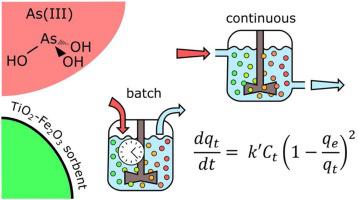Journal of Environmental Chemical Engineering ( IF 7.7 ) Pub Date : 2020-05-18 , DOI: 10.1016/j.jece.2020.104033 Jay C. Bullen , Chaipat Lapinee , Pascal Salaün , Ramon Vilar , Dominik J. Weiss

|
TiO2–Fe2O3 composites show great promise for the removal of arsenic(III) from drinking water: this single material combines the photocatalytic capabilities of TiO2 for the oxidation of arsenite (i.e. As(III)) with the high adsorption capacity of iron oxides towards the arsenate (i.e. As(V)) subsequently produced. To design an effective treatment, it is necessary to balance high sorbent concentrations, providing long filter lifetimes, with low photocatalyst concentrations, to achieve effective penetration of light into the system. In this work, we construct a predictive model using experimentally determined As(III) adsorption isotherms and kinetics to estimate arsenic treatment plant lifetimes. We considered sorbent loading, treatment time, and batch treatment versus continuous-flow. Our model indicated that batch treatment is more efficient than continuous-flow at low sorbent concentrations (<100 g L−1), and therefore more appropriate for the photocatalyst-sorbent system. However, with <100 g L−1 sorbent, media should be replaced several times per year to maintain effective treatment. In contrast, slurries of >100 g L−1 sorbent could operate for an entire year without media replacement. This work highlights the important implications of sorbent concentration when we consider the multifunctional photocatalysts-sorbent system, and highlights the need for further experimental work to design efficient arsenic treatment plants.
中文翻译:

光催化剂-吸附剂复合材料在砷(III)修复中的应用:动力学吸附模型的启示
TiO 2 -Fe 2 O 3复合材料具有从饮用水中去除砷(III)的广阔前景:这种单一材料结合了TiO 2的光催化能力用于氧化亚砷酸盐(即As(III)),随后产生了铁氧化物对砷酸盐(即As(V))的高吸附能力。为了设计有效的处理方法,必须平衡高吸附剂浓度,提供长过滤器寿命和低光催化剂浓度,以实现光有效渗透到系统中。在这项工作中,我们使用实验确定的As(III)吸附等温线和动力学来构建预测模型,以估算砷处理厂的寿命。我们考虑了吸附剂的装载量,处理时间和分批处理与连续流的关系。我们的模型表明,在低吸附剂浓度(<100 g L -1时),分批处理比连续流处理更有效),因此更适合光催化剂-吸附剂体系。但是,对于<100 g L -1的吸附剂,应每年更换几次介质以保持有效的处理。相比之下,> 100 g L -1吸附剂的浆液可以整年运行,而无需更换介质。当我们考虑多功能光催化剂-吸附剂系统时,这项工作突出了吸附剂浓度的重要含义,并强调了需要进行进一步的实验工作来设计高效的砷处理厂。


























 京公网安备 11010802027423号
京公网安备 11010802027423号